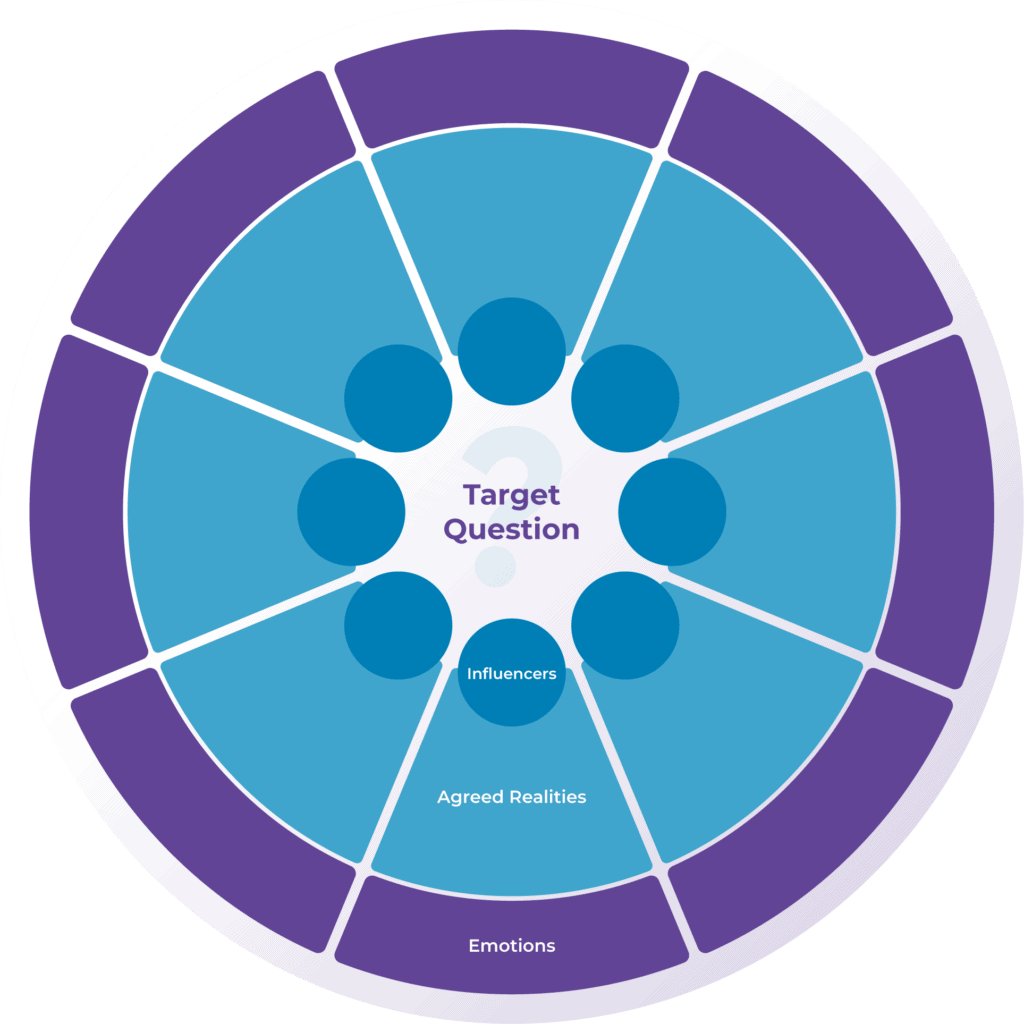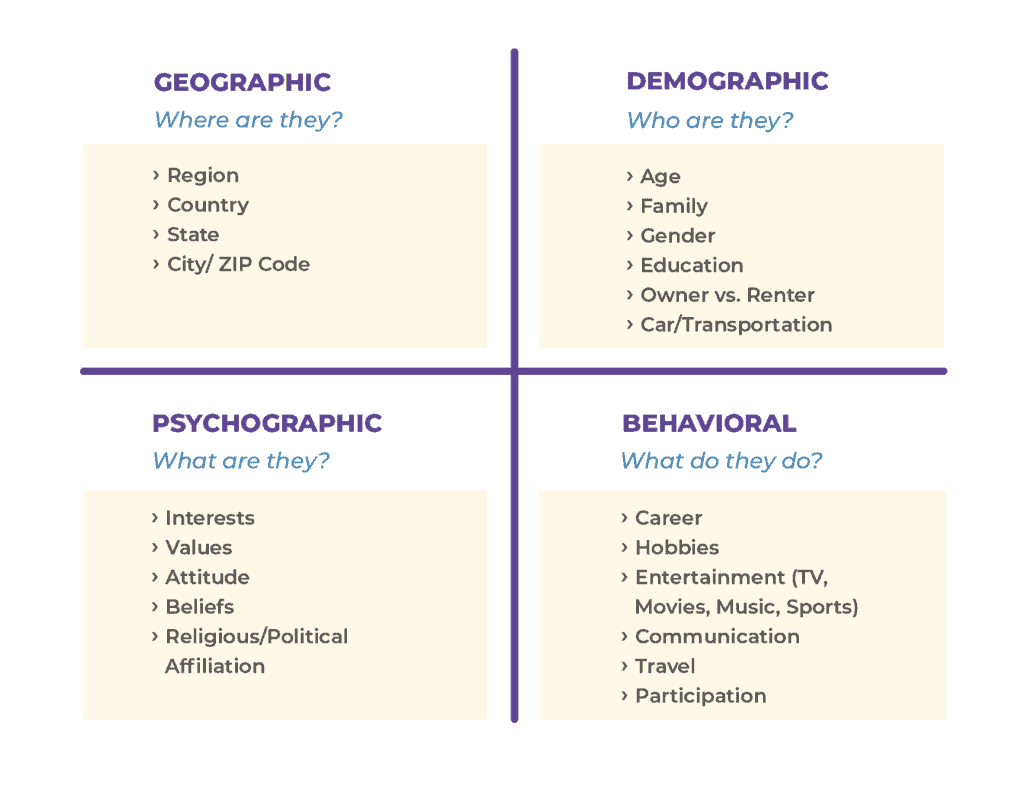Target Audiences
Who are you talking to? It may seem like a simple question, but it is one of the questions many communicators struggle to answer. Campaigners and NGOs will often say “everyone” or spin out a very broad target audience statement.
Our mapping technique is based on the technique that is used by many marketing organisations and is sometimes called “stakeholder mapping”, or “empathy mapping”. The technique was originally developed to move people to purchase products and services (traditional marketing). However, the map has applications for all communication that requires behavioural change.
This technique helps you identify:
- An attitude, behaviour, skill or knowledge gap in your audience
- Influencers for your audience
- Their beliefs about current behaviour, attitude or knowledge
- Emotional motivators
Tip! Mapping requires research. The best form of research is to interview your target community for their agreed realities and emotional payoffs. Social media is also a great resource to discover the agreed realities and emotional payoffs of your target community. Use Google Trends, or data from Google Analytics when available. By exploring statements, tweets, images, expressions and comments made by your target community or their influencers on the topic, you can develop a more rounded view of your map. This can include words or phrases that your audience uses or understands.
The video below provides an overview of the mapping technique and runs you through the different steps of the mapping process:
Broad target audiences
Broad target audiences have been a staple of media and communications for decades. Broadcasters use these to segment their shows, publications and articles. Typically, a broad target audience is based on demographic and geographic information. We can tell a great deal about a person simply by examining the demographic data about their life – their age, income level, education, occupation – but by itself, this data is only of limited use. It tells us nothing about their aspirations, their beliefs, their attitudes, or any other subjective psychological measure. Defining your broad target audience is the starting point. It is your first distillation of your audience. The next step will be to refine this audience even further.
Micro target audiences
Once you have defined a broad target audience, the next step is to create a specific target audience. To do this, the mapping technique is used. The technique was originally developed to move people to purchase products and services in traditional marketing. However, the map has applications for all communication, including behavioural or attitudinal change that is ultimately the aim.

The map uses several concentric circles from the Target Question. It consists, from the centre moving outward:
- Target Question, in which a behaviour is identified.
- Influencers that influence the behaviour or belief.
- Agreed Realities, or the beliefs about the behaviour (or attitude) and finally,
- Emotions or “emotional payoffs” for the behaviour.
Once we have discovered who the audience is that we are talking to, we can then develop strategies on how to influence this group through counter- and alternative narratives. As stated previously, the map is based on a behaviour change model. It requires the identification of a behaviour in the target audience. Once we discover why the audience has this behaviour, through understanding their beliefs, influencers and emotional drivers, we can then bring them new knowledge, skills or attitudes to change or shift it.
Target audience statement
A target audience statement is created by reading a wedge or slice of the map from the target question to the emotional payoffs It does not assume that you will reach everyone, that’s why we start the statement with the word ‘some’. Each slice of the map will present you with a different target audience statement.
Some… Community + Freely Chosen Behaviour + Influencer + Agreed reality + Emotional Payoff.
For your story, you should pick the slice you know you can have the most or most realistic impact on.
Persona creation
Personas focus mostly on psychographic and behavioural information. A persona represents different characteristics of similar people (behaviour, motivation, goals and frustrations) into one fictional character through which a group can be understood. You can create multiple personas, to describe different target (sub)groups. However, start with developing 1-2 personas, and try to keep your personas to a maximum of 6. Too many personas will result in a lack of focus and not help you and your team to create targeted, persona-specific content. Choose your most important distinctive personas, to be targeted in your activities.
Why create a persona?
Making a fictional persona can help you to get in the mindset of your target audience. It forces you to step into their shoes and think about the things he or she encounters in his or her day-to-day life. It also helps to create a visualisation and common understanding of your target audience, which makes it easier to relate to.
Tip! The YCD Toolkit contains a complete set of resources to conduct a “build personas” workshop! It will help you build personas that are relevant to your organisation, service or program from real information and data.
How to create a persona?
Although a persona is a fictional character, they should be realistic and based on research, perhaps one of the young people you interviewed comes to mind? In order to create a persona, you want to provide a clear picture on what the persona thinks, sees, hears and does.
Ask the following questions:
- What does (s)he think? What really counts, preoccupations, worries and aspirations.
- What other opinions does (s)he hear? What do friends, bosses, influencers say?
- What does (s)he do? This includes attitudes, appearance, behaviour towards others, and behaviour online. How does (s)he act on his or her opinions? What hobbies, what kind of music does (s)he listen to, what is his or her favourite brand, and how would I recognise him or her on the street?
- What are the grievances, values, interests and needs that feed into this behaviour?
- Values: community, tradition, ideology;
- Grievances: poverty, lack of things, frustrations, obstacles, fears;
- Interests: sport, community, parties;
- Needs: Safety, income, friends, acknowledgment.
Research
A persona should be realistic. In order for a persona to be useful and easy to relate to, avoid creating stereotypical users and create a persona based on research data. You will therefore need to: get data, find patterns in the data & create personas based on those patterns.

- Facts: Basic demographic information — age, gender, location.
- Relationships: Think about family, friends and professional connections.
- Activities: What do they do on a day-to-day basis? Include work, hobbies and habits.
- Digital behaviour: Their preferred social media channels, news and shopping websites.
- Wider world: What positive and negative trends in society affect and/or preoccupy them?
- Feelings: How do they feel at this point in time?
- Drives: What is pushing them towards your organisation?
- Goals: What are their goals? What is the problem they are experiencing and how can you help them solve it? What do they want to achieve through your organisation?
There are many tools available that can help you find the kind of information needed to be able to create a persona. You can use social media analytics, focus groups, baseline research, surveys, Google Trends, interviews, etc.
Key takeaways
- Mapping is the process of understanding the logic and emotional drivers of your audience.
- The Target Question is always behaviour based. Behaviour is the outward expression of belief or attitudes.
- Agreed Realities are not what you believe or know what is right, rather it is the “logic” of the target community in the map. If they believe the earth is flat, what is THEIR Logic.
- Emotions are essential in understanding why we do things.




